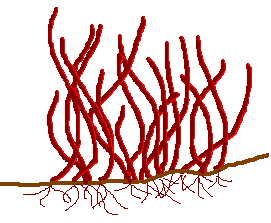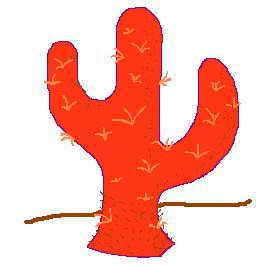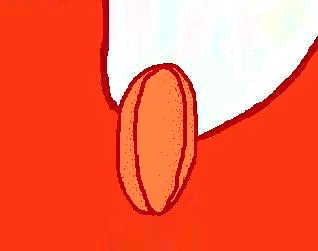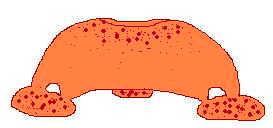
Balotan Producers
Thrumbler
Various types of Thrumbler cover much of Balota's fertile soil, giving the landscape its characteristic red color. Most are between half a meter and one meter high. During the wet season, a Thrumbler is a grass-like photosynthetic plant (with pigments absorbing mostly blue and green light and some infrared, resulting in a dark red plant color (3)) with thin, rubbery stalks and leaves. Its shallow root system obtains plenty of water and nutrients from the rich, moist soil.

A fully hydrated Thrumbler
During the three-month dry spell, however, the Thrumbler changes drastically. Although the plant's rubbery surface, relatively thick stalks, and sparse stomata (4) cut down water loss, after a few weeks, the plant runs out of water as the environment dries out. As it loses water, the stalks and leaves curl back on themselves, forming a spherical mesh of plant matter, and the roots slowly retract and draw themselves into the sphere:

A dried, spherical Thrumbler
With detached roots and extremely low levels of water, the resultant sphere is light, slightly brittle, and easily pushed by wind. The strong winds that blow thoughout the dry spell can push a Thrumbler for several kilometers. Some of the Thrumblers travel to other dry regions where they die of prolonged water loss, but many Thrumblers get blown out of the dry zones and into wetter environments, where they slowly rehydrate and take root again. This strategy also helps Thrumbler reproduction: with periodic movement, the plants move away from close relatives and into new regions, encouraging greater genetic diversity.
The Pillariler is a large plant found in most parts of Balota. Mature Pillarilers can grow to over 3 meters in height. Like Thrumblers, Pillarilers have thick, rubbery surfaces that discourage water loss. During wet weather, the stomata of Pillarilers are open constantly, and the leaves spread out for maximum light absorbancy. The underside of the leaves is waxy like the rest of the surface, but the tops are much less water-retaining. During the rainy season, the Pillariler often leaks excess water out of the leaves to avoid over-hydration. Many Balotan animals visit Pillarilers to lick the water off the leaves, which keeps the water from running back down the trunk and into the Pillariler's root system.

The Pillariler
During the dry season, the Pillariler closes its leaf clusters, with the water-inefficient tops enclosed in the center of the clump and the waxy undersides facing outwards. This, along with the closing of the stomata, greatly reduces water loss.

A closed leaf cluster on the Pillariler
The several gallons of water stored in the trunk are then enough to sustain the plant until the next wet season. To discourage water theivery by other organisms, such as the Sneakler, the Sloogler, and the Carapler, Pillarilers have short, sharp spines growing on the bottom part of their trunks.
The Nomadler is one of the more unusual plant species on Zlerin. Nomadlers are constantly traveling across Balota in search of water. They use their three pseudopod-like "feet" to move. If it is in a hurry, a meter-wide Nomadler can move at speeds up to 10 feet per minute. These large energy expenditures are balanced by extremely slow growth and hyperactive photosynthesis. The "feet" of Nomadlers are covered in tiny hairs that suck water out of the ground they ooze over. This is not nearly enough water to power extensive movement, so Nomadlers also have a large depression in their main body where rainwater is collected and absorbed. Many animals have discovered this alternative water source, however, so Nomadlers must absorb the water quickly. The Nomadler's body does not store much water, compared to the Pillariler. Its main section is a large shell less than 1 centimeter thick. This cuts down on its weight and the energy required to propel it. The shell also maximizes surface area for photosynthesis, increasing the energy absorbed by the plant.

The Nomadler
With luck, most Nomadlers manage to avoid or leave the dry areas, but some wander into the dry areas by accident. These plants usually die, providing food for scavengers like the Nyootler or the Sneakler. Over the past few hundred years, however, some strains of slightly bluish Nomadler have developed methods of producing a strong acid and storing it in sacs within the main body. When these Nomadlers are eaten, the unlucky predator soon has an episode of explosive vomiting, losing all the water and nutrients gained from the Nomadler, and then some. These new bluer Nomadlers have been increasing in numbers, slowly outnumbering normal Nomadlers. Within the next few centuries, the Sneakler or Nyootler may evolve a new resistance to this acid.